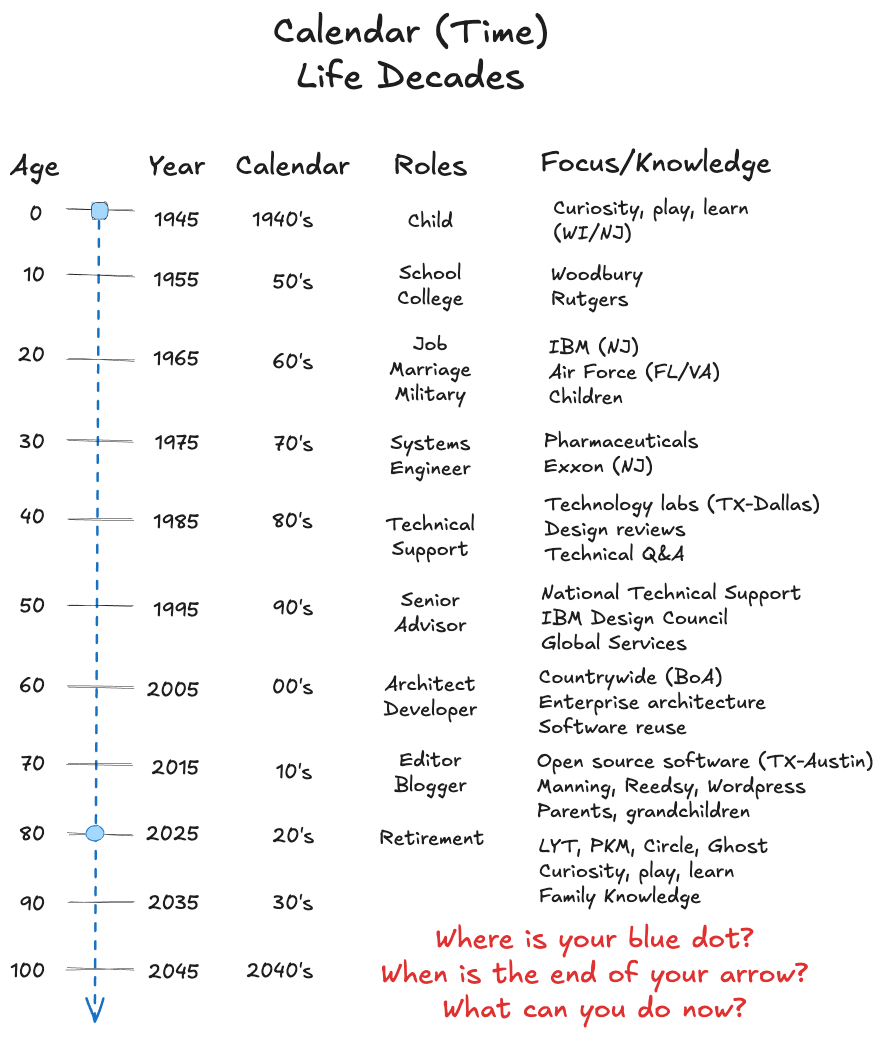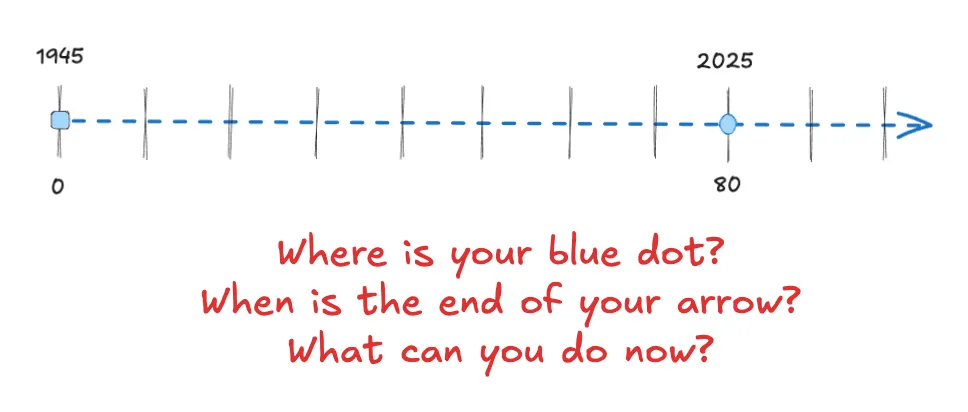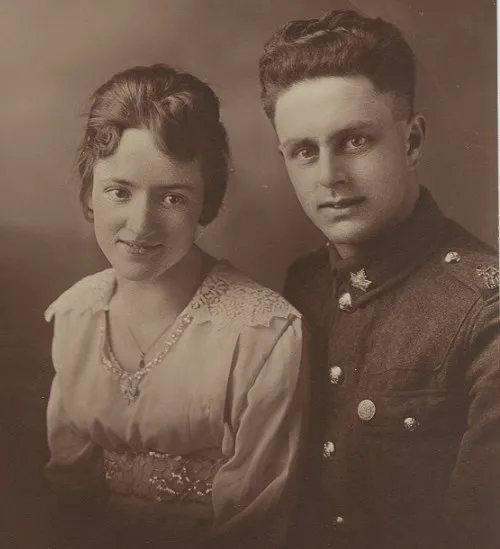Since I will be 80 soon, it's time to focus on my life so far and how I can prepare my family for life after me. I was thinking about time and knowledge in the 8 decades of my life.
Calendar
Since I was born in mid-year (July) in the middle of a calendar decade (1940's), it helped to identify the year that started each decade such as age 20 in 1965, as well as the calendar decade period like the 60's. Also, I thought of my primary roles during each period as well as my focus and knowledge. I was born in Wisconsin, grew up in New Jersey, have lived in Florida and Virginia, and now Texas.
Life on a page
This is a summary of my life by decade with roles, focus, and knowledge.

Job
A lot happened between 1965 and 1975 after graduating high school in Woodbury and college from Rutgers University in 1967. I got a job with IBM as a Systems Engineer in New Jersey initially with pharmaceutical clients and later, after returning from Air Force leave, with Exxon for 8 years before moving to Dallas.
While staying in a Newark hotel for 10-week training, guns and fires outside caused me to escape a week early during the 1967 urban riots after assassinations of Martin Luther King and Robert Kennedy because I was getting married a few weeks later.
Marriage
I was married in 1967 and we have two sons. I remember when my first son was born at the Langley Air Force Base hospital, in those times they wouldn't even let me be with my wife for the birth; they told me to go home and they would notify me when it was over and I could come and visit.
A year after my discharge, we had our second son, and my wife's labor was so fast she never even had a chance to get her knee socks off since we were racing to get there on time, but it was a civilian hospital and was able to be present that time.
Military
Initially, I had an occupational deferment while I in training with IBM, but they eliminated all deferments the following year in 1968 at the peak of the Vietnam War so my name popped right to the top of the draft list because I was 23 at the time and they were running out of 18 year-olds to draft.
Somehow I found out I was about to be drafted into the Army (probably infantry) for 2 years, so I decided to enlist in the Air Force for 4 years; I thought that would offer a better chance to use my IBM computer experience in the Air Force. And I actually worked as a system programmer with IBM Federal Systems and Mitre Corporation on advanced command & control and intelligence data systems.
Housing & hurricanes
Since I was on an IBM military leave of absence, I received half my salary for 2 years that helped a lot on my Airman's pay. I remember the first place that we visited out in the country near Eglin AFB actually had dirt floors, and my wife immediately broke down crying when the realtor showed it us.
We settled for a small cinder block single-story home with linoleum floors, plastic furniture, and gigantic flying roaches where we hunkered down during Hurricane Camille (after initially driving north via Alabama until we had an oil leak and turned back) . It became was easier as I was promoted to Sergeant and eventually Staff Sergeant.
Senior advisor
During the next 4 decades, I focused on my career as a systems engineer, technical support, senior advisor, software architect, and developer with IBM National Technical Support, IBM Global Services, and Countrywide Financial (now Bank of America).
I was appointed as one of the first Senior Advisors in the IBM National Technical Support Center. That was the highest, non-management technical position, serving as a senior technical expert and trusted advisor to both internal teams and customers during a period of IBM's transformation into software, services, and consulting. this was similar to a Senior Technical Staff Member or Distinguished Engineer in development divisions.
Technical support
As Senior Advisor to executives, management, and support teams, I shaped technical direction and strategies to adapt technical support for new architectures and technologies. I provided technical support, design reviews, early support programs, and critical situation support for specialists, consultants, and customers.
Technology labs
I also established several technology labs and centers of excellence to enable and support early adoption of new technologies in distributed computing, PC networking, LAN systems, and interconnected systems.
IBM Design Council
Also, I was a member representing National Technical Support and later Global Services with executives, senior technical leaders, architects, and planners in the IBM Design Council that was a strategic, cross-divisional initiative managed by IBM Software Group.
Its focus was to guide and coordinate major cross-divisional technology directions and standards on open distributed systems, Open Blueprint initiative, Systems Application Architecture (SAA), Java and object technology in product roadmaps and interoperability strategies in systems and software products.
Enterprise architect
After leaving IBM, I became a Software Architect in the Office of Architecture at Countrywide Financial (now Bank of America). I focused on service-oriented architecture (SOA), web services, software reuse, and architecture governance across multiple business units, project teams, and technologies.
Editor & blogger
Since I retired in 2001 as a Senior Advisor after 34 years with IBM, I because a software architect for another 6 years. Over the last 25 years, I continued my interest in open source software technologies as a technical reviewer, editor, and proofreader for Manning Publications and later as an editor for Reedsy Ltd.
I started a personal blog on Wordpress over 10 years ago, and last year migrated to Ghost for my blog, website, and newsletters.
Parents & grandchildren
During the first 15 years of my retirement, I cared for my aging parents since my mother had Alzheimer's disease and my father eventually had vascular dementia. So I know what it's like when you lose your memory and the impact it has on those caring for them in assisted living, memory care, nursing home, and hospice.
I remember when my father was overwhelmed with my Mom's diagnosis and his own health issues, he was dealing with a urinary catheter situation for an enlarged prostate in a nursing home after a hospitalization. He just wanted to die and refused to eat thinking that he would die, so they considered him suicidal and committed him to a geriatric psychiatric hospital. We had to follow behind the police car driving at 70 mph with him in a nightgown on the back seat to Corpus Christi for treatment and recovery.
After my father had a serious fall in the bathroom during one night in their memory care room, he was taken to a nursing home for rehab (that never really helped him recover); he declined rapidly over his last year with vascular dementia and lots of rage, paranoia, disrobing in the dining room, biting nurses, throwing shoes, etc. (he wasn't a "happy camper").
My mother never even realized that he had gone, although she would ask "Where's Corky?" occasionally (and then forget a few minutes later). We usually told her that he was probably at "physical therapy", which he had being doing, and she accepted that explanation. It was frustrating that we could never even tell her husband of 69 years was dead because she would not understand.
During same time, we have been lucky to be close to our 3 grandchildren and spent a lot of time with them reading bedtime stories, babysitting, celebrating birthdays and holidays, going to movies, doing other activities together, watching soccer games, and now enjoying their experiences in high school and college.
Curiosity
It's interesting that my early life focused on curiosity, play, and learning; and now in retirement, I have the time to return to them again in the later stages of my life.
Over the past few years, I have been very active with personal knowledge management (PKM) through Nick Milo and the Linking Your Thinking (LYT) team, community, newsletters, videos, workshops, and events. I have also been involved with Anne-Laure Le Cunff at Ness Labs related to Tiny Experiments and associated mindful productivity and other neuroscience insights.
Family knowledge
I have published a lot on app integration with Obsidian among other PKM topics and other interests. However, this year my primary focus in my Family Knowledge effort including these articles. So follow along to hear more.
Summary
This has been helpful to step back and review my life over time from the perspective of major focus and knowledge throughout each decade. You might consider doing something similar; such review, reflection, and journaling can be very helpful as you assess what you have done, where you are now, and what's next?
Your Arrow
What does the arrow of your life look like?
Me and My Arrow (2:06)
This is an oldie from Harry Nillson in 1970.
Spotify song link: https://open.spotify.com/track/5KjRITicSHJM88w3U9LwLM?si=2faa6928b96d458e
And here's music and a video from The Head and the Heart on their latest album Aperture (2025) while you're thinking about what you can do, especially to help your family?
Arrow (3:14)
Spotify song link: https://open.spotify.com/track/1SddmjX60LKydFCMXPtMdV?si=0970b1964cd042ab
After the Setting Sun (4:30)
This song explores themes of loss, memory, and hope, with lyrics reflecting on what comes after endings and the importance of connection.
"When you least expect it / When you've reached the end / There's a door that opens up / After every setting sun..."
YouTube video link: https://www.youtube.com/watch?v=IOvuw7pKfv4



